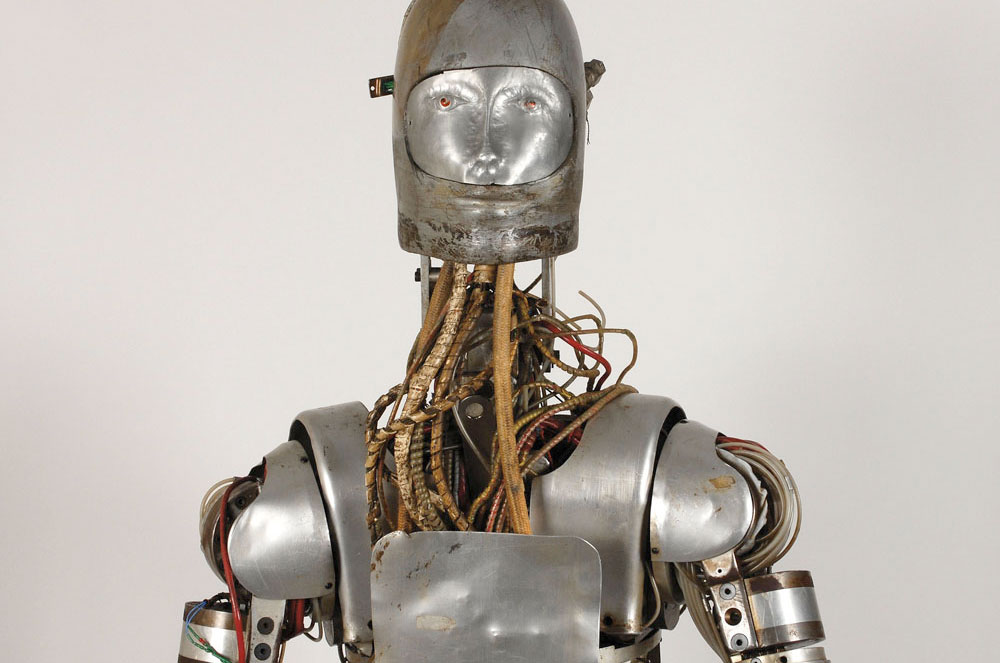Robot Designed to Test NASA's Pre-Apollo Spacesuits Heads to Auction

Before NASA launched men to walk on the moon, the space agency almost turned to a human-like robot to test its astronauts' prototype spacesuits.
The hydraulic-powered android might have worked, too — had it not been for its tendency to leak oil when used.
Now, 50 years after its rejection, one of the robot dummies is set to be sold among 100 "Remarkable Rarities" offered by RR Auction. The 10-day online auction will begin Sept. 15 and culminate in a live sale at Royal Sonesta Boston on Sept. 26.
"Only two of the test robots were produced — the other is on display and owned by the Smithsonian National Air and Space Museum," Robert Livingston, RR Auction executive vice president, in a statement. "This [robot] was purchased as surplus from the University of Maryland." [Meet Valkyrie: NASA's Humanoid Robot in Photos]
The so-called "Power Driven Articulated Dummy" project ran from May 22, 1963 through July 31, 1965. Produced by the IIT Research Institute in Chicago, the robot could be used to simulate 35 basic human motions. It was equipped with sensors at each joint to measure the forces imposed on the human body by a pressurized spacesuit.
"It was impressive on the motions it could make," said Joe Kosmo, a retired NASA suit engineer, in an interview with space historian Andrew Chaikin for Smithsonian magazine in May, describing the robot on display at the institution's Steven F. Udvar-Hazy Center in Chantilly, Virginia.
Though a person could climb into a spacesuit and describe how it felt, the articulated dummy was designed to provide quantitative data for a more scientific approach to refining the suit's design.
Get the Space.com Newsletter
Breaking space news, the latest updates on rocket launches, skywatching events and more!

That is, if it didn't destroy the spacesuit in the process.
The robot dummy's movements were enabled by hydraulic actuators powered by oil that flowed through a nylon-tube circulatory system. The design allowed for the android to swivel its hips, raise and lower its arms and legs, shrug its shoulders, clench its fists, and even shake hands — but it could not handle the pressure needed to move the robot's extremities without leaking. [The Evolution of NASA Spacesuits (Photos)]
"Leaking oil would contaminate the suit. We didn't want to risk ruining a suit," stated Kosmo. "You couldn't place the dummy inside a one-of-a-kind spacesuit."
Despite trying some creative solutions, including outfitting the robot in a scuba diving wetsuit, the problem was never solved. NASA dropped the project and directed its funding elsewhere.
"This remarkable robot [dummy] stands as a testament to the innovative creativity NASA inspired," Livingston said.
Weighing 230 lbs. (104 kg), the android's height could be adjusted from 5 feet, 5 inches to 6 feet, 2 inches (1.5 to 1.8 m) to represent the average American male from the 5th to 95th percentile. The robot's exterior was covered with an aluminum skin and topped with a fiberglass head. Its "face" could be removed to access interior connections.
The dummy up for auction is missing a forearm and hand, has various scuffs and dings to its body, and some of its wiring is frayed or damaged, according to RR Auction. It is estimated to sell for more than $80,000.
The spacesuit test robot is included among a dozen other aviation and space exploration artifacts being auctioned as part of RR's Remarkable Rarities sale.
Other auction highlights include a nearly 2-foot-long (61 cm) exterior panel fragment from NASA's Mercury 1 space capsule and a 1969-1970 guest book from Richard Nixon's Air Force One signed by Apollo 11's Neil Armstrong, Buzz Aldrin and Michael Collins, the wives of the Apollo 13 crew and President Lyndon B. Johnson, among other historical NASA leaders.
See NASA's spacesuit test robot in action in a Smithsonian video at collectSPACE.com.
Follow collectSPACE.com on Facebook and on Twitter at @collectSPACE. Copyright 2016 collectSPACE.com. All rights reserved.
Join our Space Forums to keep talking space on the latest missions, night sky and more! And if you have a news tip, correction or comment, let us know at: community@space.com.

Robert Pearlman is a space historian, journalist and the founder and editor of collectSPACE.com, a daily news publication and community devoted to space history with a particular focus on how and where space exploration intersects with pop culture. Pearlman is also a contributing writer for Space.com and co-author of "Space Stations: The Art, Science, and Reality of Working in Space” published by Smithsonian Books in 2018.In 2009, he was inducted into the U.S. Space Camp Hall of Fame in Huntsville, Alabama. In 2021, he was honored by the American Astronautical Society with the Ordway Award for Sustained Excellence in Spaceflight History. In 2023, the National Space Club Florida Committee recognized Pearlman with the Kolcum News and Communications Award for excellence in telling the space story along the Space Coast and throughout the world.










